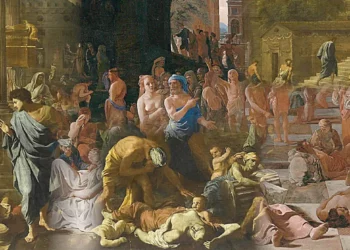
Archaeologists have discovered a 2,000-year-old Roman sandal near an ancient military fort in Oberstimm, Germany. The highly rare find provides a unique glimpse into the military equipment used by the famous legionaries.
The only remnants of the leather shoe were its sole and some well-preserved nails. Researchers analyzed the footwear fragments using X-rays, which revealed the shoe to be a caligae — Roman military boots. This type of heavy-duty, hobnailed sandal was part of the standard uniform issued to Roman legionary soldiers and auxiliaries around that time. The nails in the sole provided traction for marching soldiers.
Researchers unearthed the ancient military-style footwear during an excavation at a civilian settlement on the outskirts of the Roman military fort. The settlement dates back to between A.D. 60 and 130, according to the Bavarian State Office for Monument Preservation (BLfD).
Ancient Roman Footwear
Caligae were designed to protect soldiers from blisters and trench foot. This footwear typically had a thick sole consisting of several layers of goat, sheep, or cow skin. It was also studded with iron or copper studs (clavi caligarii). This solid sole guaranteed the stability and durability of the footwear. Straps covering the instep and the lower leg secured the sandals in place on the feet.

Interestingly, the third Roman emperor, Caligula, got his nickname from the small caligae he wore as a boy among his father’s soldiers. Caligula (born Gaius Caesar) literally means “little boot”, a rather benign nickname for the infamous leader. Even today, the name Caligula serves as the personification of cruelty and erratic behavior — although the ‘mad emperor’ never made his horse a consul; that’s a myth.
“So-called caligae were mainly worn by Roman soldiers during the Roman Empire,” Amira Adaileh, a consultant at the BLfD, said in the statement. “The find makes it clear that the practices, lifestyles and clothing that the Romans brought with them to Bavaria were adopted by the local people.”
In addition to the sandal, excavations at Oberstimm revealed food scraps, pottery, a sickle, and various costume components. These artifacts collectively provide a richer understanding of daily life in this ancient community.
By the end of the first century A.D., the Roman army began transitioning to enclosed boots known as calcei. You can think of caligae as sandals and calcei as shoes. This shift was driven by the need for greater protection and durability in diverse and harsher climates as the empire expanded across the continent’s varied terrains.

At the edge of the Roman Empire, near Hadrian’s Wall in what is now northern England, the Vindolanda archaeological site has yielded a remarkable collection of Roman shoes—over 7,000 of them. These shoes, preserved in the oxygen-free mud of Vindolanda’s fort ditches, offer a rare window into daily life nearly two millennia ago.
Founded around AD 85 during the Roman conquest of Britain, Vindolanda served as a military outpost and played a crucial role in the defence and administration of the northern frontier of the Roman Empire. The fort was strategically situated along the Roman road known as the Stanegate, which linked the forts of Corbridge and Carlisle.
Unlike the uniform sandals often associated with Roman soldiers, the Vindolanda shoes reveal surprising diversity: children’s booties, fashionable women’s slippers, rugged military calcei, and sturdy work shoes. The variety of styles reflects influences from across the Empire, with soil conditions helping to preserve the leather and materials.

The shoes show advanced techniques such as intricate lacing, stitching, and the use of hobnails for reinforcement, especially in the soldiers’ boots, designed for long marches across rugged terrain. Many of these shoes bear striking similarities to modern footwear, with clear attention to functionality, style, and durability.

Besides shoes, some of the most extraordinary discoveries at Vindolanda are the collection of “Vindolanda tablets,” which are thin pieces of wood inscribed with ink and serve as some of the oldest surviving handwritten documents in Britain. These tablets include letters, orders, and personal messages that reveal details about military campaigns, the relationships between soldiers and locals, and the challenges of life on the frontier.

By the end of the 4th century, however, Vindolanda fell into decline, and the fort was eventually abandoned. Today, Vindolanda is a UNESCO World Heritage Site and is part of the larger Hadrian’s Wall complex, which was constructed later in the Roman occupation.






